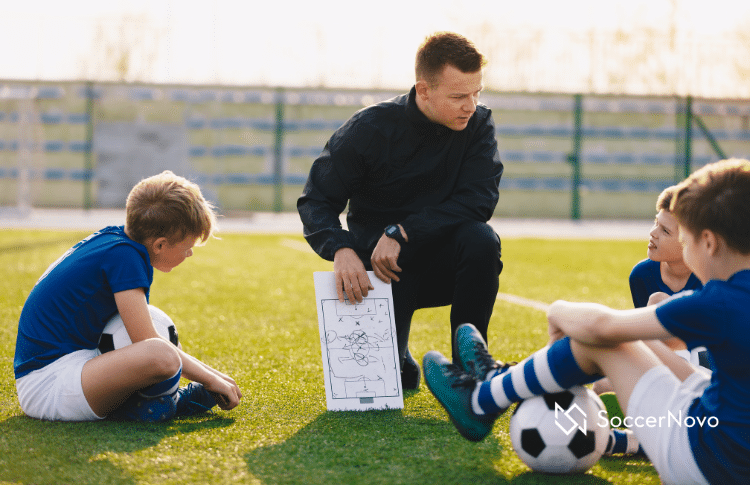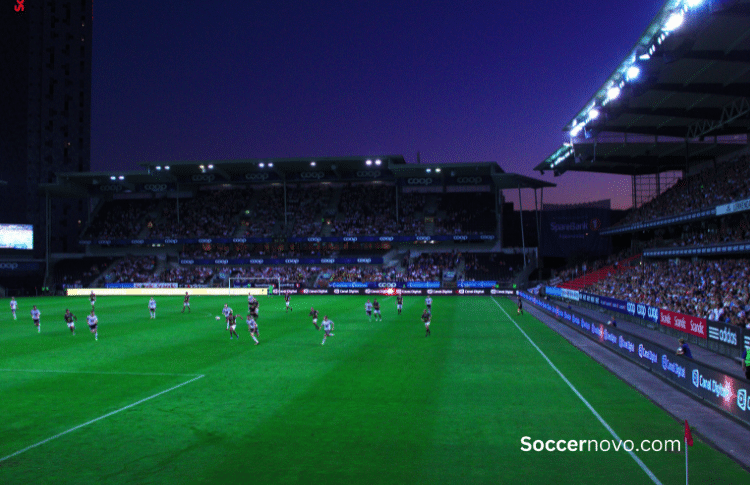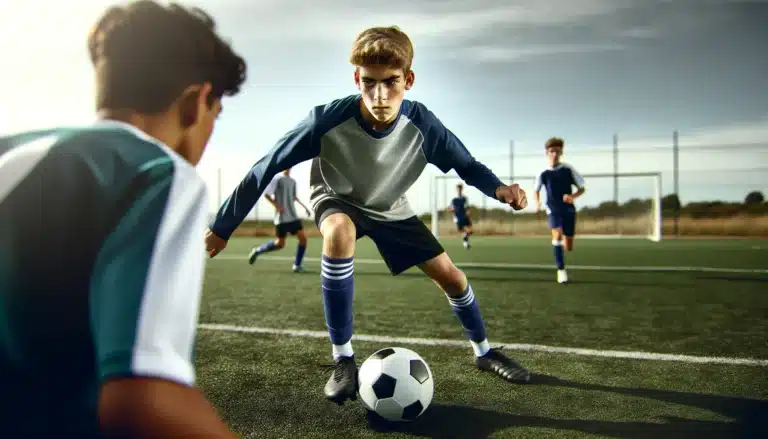How to Teach Positions in Soccer: A Comprehensive Guide

If you are a coach or parent looking to teach positions in soccer, you’ve come to the right place! To teach soccer positions, you need to have a solid understanding of the game and its basic rules.
In my opinion, developing soccer skills should be priority number one. Second, would be to introduce different soccer positions and ensure the players know where he or she needs to be and what they should be doing. As a coach, it’s equally important to put them in the best possible scenario to succeed. For example, you probably wouldn’t want to put your quickest and fastest kid on defense.
Key Takeaways From This Article:
- As a coach, you need to start with the basics of soccer positions (goalie, defense, midfield, and forward).
- Each soccer position will require specific skills in order to succeed.
- Younger kids should try out different soccer positions. As they get to U13, they’ll naturally gravitate to one or two primary positions.
Knowing the positions is essential to developing a successful team, and it’s crucial that each player knows their role and responsibilities on the field.

In this article, we’ll cover the basics of teaching positions in soccer, including the different positions and their roles.
Understanding Positions in Soccer
Goalkeeper
The goalkeeper is the last line of defense for your team. Their primary responsibility is to prevent the other team from scoring goals.
They are the only player allowed to use their hands within the penalty area. In addition to good hands, they should still work on their passing. A goalie that can prevent goals and play with their feet can find a lot of success.
The goalkeeper must have good reflexes, be able to communicate effectively with their teammates, and have excellent positioning skills.
Defenders
Defenders play in front of the goalkeeper and are responsible for preventing the other team from getting close to the goal.
They must be able to tackle effectively, block shots, and clear the ball out of danger. They must possess good discipline and not be afraid to make strong tackles.
Defenders are also responsible for starting attacks by passing the ball to their midfielders.
Midfielders
Midfielders play in the middle of the field and are responsible for both attacking and defending.
They must be able to pass the ball accurately, control the ball well, and be able to read the game to intercept passes and make tackles.
Midfielders are the glue between the defense and the forwards and are responsible for creating scoring opportunities for their team.
Forwards
Forwards are responsible for scoring goals.
They play in the opposing team’s half and must have good dribbling skills, be able to shoot accurately and have good positioning to receive passes from their teammates.
Forwards must also be able to work well with their teammates and create scoring opportunities for themselves and others.
For further learning, check out ‘Soccer Positions: The Ultimate Guide’
Teaching the Basics of Each Soccer Position

Goalkeeper Basics
As a coach, teaching the goalkeeper position should start with the basics. The goalkeeper’s primary role is to block, catch, or deflect any shots going into the net. Here are some key basics to teach a goalkeeper:
- Positioning: The goalkeeper should position themselves in the center of the goal, with their weight on the balls of their feet. They should adjust their angle if the ball goes to one side or the other.
- Hand positioning: The goalkeeper should keep their hands in front of their body and be ready to make a save.
- Anticipation: As a goalie, it is important to anticipate the offensive player’s moves and react quickly. Keep your knees bent and head on a swivel.
- Footwork: The goalkeeper should be able to move quickly and efficiently around the goal area. It’s advantageous to keep the feet light and react with a bounce in the step.
- Communication: The goalkeeper should communicate with their defenders to organize the defense.
For more advanced training techniques, check out this video…
Defender Basics
Defenders are responsible for protecting the goal and stopping the opposing team from scoring. Here are some key basics to teach a defender:
- Positioning: Defenders should be positioned between the opposing team’s attackers and the goal.
- Tackling: Defenders need to be able to tackle the ball away from the opposing team’s attackers. Going shoulder-to-shoulder is permitted.
- Marking: Defenders should mark the opposing team’s attackers to prevent them from getting the ball.
- Communication: Defenders should communicate with their teammates to organize the defense.
Midfielder Basics
Midfielders are responsible for controlling the midfield and helping both the defense and the attack. Here are some key basics to teach a midfielder:
- Passing: Midfielders need to be able to pass the ball accurately and quickly.
- Vision: Midfielders need to be able to see the whole field and make good decisions.
- Tackling: Midfielders need to be able to tackle the ball away from the opposing team’s midfielders.
- Checking: Moreso than any other position, midfielders should consistently be checking their shoulders.
- Communication: Midfielders should communicate with their teammates to organize the team’s attack and defense.
Forward Basics
Forwards are responsible for scoring goals and creating goal-scoring opportunities. Here are some key basics to teach a forward:
- Shooting: Forwards need to be able to shoot accurately and with power.
- Movement: Forwards need to be able to move quickly and efficiently to create space and get into scoring positions.
- Passing: Forwards need to be able to pass the ball accurately to their teammates. This may mean passing backward so they can continue their run down the field.
- Communication: See a theme here? Forwards should communicate with their teammates to create goal-scoring opportunities.
Role of a Coach in Teaching Positions
As a coach, your role in teaching positions in soccer is crucial. It is your responsibility to ensure that your players understand the various positions on the field and how each position contributes to the team’s success.
To effectively teach positions, you must have a thorough understanding of the game and the roles of each player yourself. You should also be able to communicate this information clearly and effectively to your players.
One way to teach positions is through visual aids such as whiteboards, diagrams, and videos. These can help players visualize where they should be on the field and what their responsibilities are in their respective positions.
It is also important to provide your players with opportunities to practice playing in different positions. This will not only help them understand the roles of each position but also improve their overall development.
As a soccer coach, you should also encourage your players to ask questions and provide feedback. This will help them better understand their roles and the game.
It is also important to let the kids play scrimmages so they get a game-like experience. This will also help provide teaching moments during the practice session.
Using Soccer Drills to Teach Positions

Position-Specific Drills
When teaching positions in soccer, it’s important to use drills that focus on specific skills and movements required for each position. You can use them as stations or focus on them one at a time during practices.
At a high level, here are some drills you can use for each position:
Forwards
- Shooting and finishing drills: These drills focus on developing the ability to score goals and finish plays.
- Dribbling drills: These drills focus on developing the ability to beat defenders and create scoring opportunities.
- Crossing drills: These drills focus on developing the ability to deliver accurate crosses into the box.
Midfielders
- Passing and receiving drills: These drills focus on developing the ability to control the ball and distribute it effectively.
- Possession drills: These drills focus on developing the ability to maintain possession of the ball and control the pace of the game.
- Transition drills: These drills focus on developing the ability to transition from defense to offense and vice versa quickly.
Defenders
- Tackling and blocking drills: These drills focus on developing the ability to win the ball and prevent opposing players from scoring.
- Clearing drills: These drills focus on developing the ability to clear the ball out of danger and reset the defense.
- Marking drills: These drills focus on developing the ability to stay with opposing players and prevent them from getting into scoring positions.
Team Drills
In addition to position-specific drills, it’s important to use team drills that simulate game situations and require players to work together. Here are some team drills you can use:
- Small-sided games (Rondos): These games allow players to practice their skills in a game-like setting with fewer players on the field.
- Scrimmages: These full-field games allow players to practice their skills in a more realistic game setting.
- Set-piece drills: These drills focus on developing the ability to execute set-piece plays such as corner kicks and free kicks.
By using a combination of position-specific drills and team drills, you can help your players develop the skills and knowledge necessary to succeed in their respective positions and as a team.
Common Mistakes and How to Correct Them
Positioning Errors
One of the most common mistakes when teaching soccer positions is not emphasizing the importance of proper positioning.
Players may tend to drift out of position, which can lead to gaps in the defense or missed opportunities on offense. To correct this mistake, you should:
- Emphasize the importance of staying in position and the impact it has on the game. For example, a defender who is too far up can get exposed by a through ball from the wing. In this example, teach them how to be in a position to intercept the ball and start the counter-attack.
- Use drills that focus on positioning and reinforce the correct behavior.
- Provide feedback and correction when players drift out of position. Depending on the age of the player, you may need to give them a little more leeway.
Tactical Errors of Soccer Player Positioning
For older youth teams (U14 and older), tactical errors can also be a problem when teaching soccer positions.
Players may not understand their role in the team or how to work together with their teammates to achieve the desired outcome. To correct this mistake, you should:
- Emphasize the importance of teamwork and how each player’s role contributes to the team’s success.
- Teach them about the various soccer formations and the reason why your team plays it the way you do.
- Use drills that require players to work together and reinforce the importance of tactical awareness.
- Provide feedback and correction when players fail to execute the correct tactics.
Conclusion
There’s no doubt that teaching soccer positions is an important part of a team and player’s development.
At the younger ages (10 and younger), I think that fundamental skill development is more important to a player’s development than learning about specific positions.
As kids mature and get better at soccer, coaches should implement teaching strategies and moments for positions.
Allowing youth soccer players to play various positions will help their development. Each soccer position requires a unique set of skills. All the skills are complimentary of each other so they aren’t wasted.
A word of caution, sometimes verbally explaining soccer positions could go over the player’s heads after a few minutes. It’s best to whiteboard it out and get playing experience! So visually explain your concepts then play a game. Periodically stop the scrimmage to explain what you see. Over time, you’ll see an improvement in your team’s play and the player’s development!

Written By: Beau Bridges
Beau is the founder of SoccerNovo, dedicated to helping players and parents navigate the youth soccer landscape. As a former youth coach and soccer parent, he shares insights on player development, recruiting, and the ever-evolving soccer scene in the U.S.
Let’s connect





